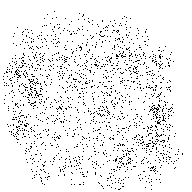 (animation)
(animation)Trifid
Nebula
Keyhole
Nebula
Great Nebula
in Orion
The internal pull of gravity eventually caused a collapse of a nebulae. Just as water "beads up" due to the internal attraction of water molecules, gas in a nebula also "beads up" into individual lumps which eventually become stars.
 (animation)
(animation)Around many of these new stars astronomers are finding disks of debris called proplyds which could very well be planetary systems forming around the central star.
Most of the gas making up these nebulae is hydrogen (about ¾) and helium (about ¼) ... leaving only a few percent for all the other elements on the periodic table.
It is also worth mentioning here that each of these nebula is capable of producing a "litter" of hundreds to thousands of individual stars. Most having a mass less than our sun.
It is now known that if you can get hydrogen hot enough ... and close enough ... it will fuse into helium. In fact, it takes 4 hydrogen atoms to create 1 helium atom (in a series of complicated reactions). This is the key to understanding the stars. Deep in the interior of young stars, the hydrogen (which makes up most of a star) is hot enough and under enough pressure to fuse into helium. Once this process starts, it can keep going for a very long time (depending on the mass of the star). A "normal" star is a fusion machine in perfect balance. Gravity is trying to pull the star closer together and the pressure from the nuclear reaction trying to push the star apart.
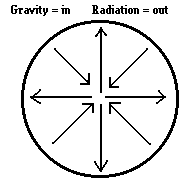
Approximately 90% of all stars seen are producing energy in the fashion described above. These stars are known as main sequence stars. That is, they are producing energy by fusing hydrogen to helium in their cores. Astronomers say that our sun will have a main sequence lifetime of 10 billion years. However, not all stars are burning their fuel at the same rates. This depends on the mass of the star. High mass stars (up to 50 times the mass of the sun) can go through their supply of fuel in a very short time (by comparison) ... remaining on the main sequence for only 10 million years. Low mass stars have such a long main sequence lifetime that the universe is not old enough for any of them to have run out.
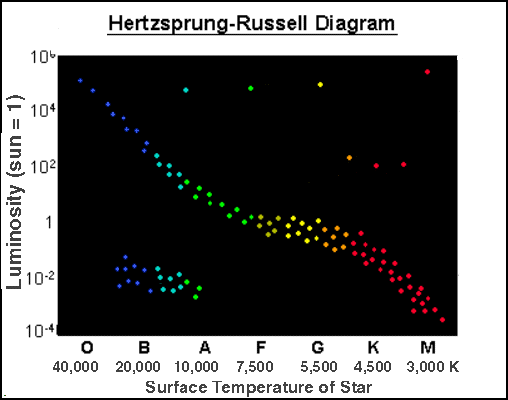
Stars also vary in temperature. All stars are gaseous with several layers in the outer atmosphere that we know of. When we refer to the "surface temperature" of a star, we refer to the layer known as the photosphere (where the sun looks like it ends to our eyes). Our sun's photosphere is about 6,000 K (11,000 F). The range of stellar temperatures is from 3,000 to 40,000 K. Cool stars appear red in color and hot stars appear blue in color. Astronomers give a designation called spectral class to indicate the temperature of stars. The sequence (from hottest to coolest) is : O B A F G K M. this is further subdivided from 0 - 9 ... so a B3 star is slightly hotter than a B4 star. Using this standard, our sun is classified as a G2 star.
What causes this distribution of
stars along the main sequence? The reason for the dispersion of stars along the main
sequence results from the different masses of the individual stars.
Stars with a high mass have huge fusion cores and burn their fuel at incredible
rates ... making them hot, bright and short lived. Low mass star
(the most common by far) burn their fuel at a snail's pace and are therefore
cool, dim and live a long, long life on the main sequence.
|
|
|
|
|
|
| High | Upper left corner | very rare | hot and luminous (blue) | very short |
| Medium (sun) | middle | somewhat rare | sun = 10 billion yrs | |
| Low | Lower right corner | very plentiful | cool and dim (red) | very long |
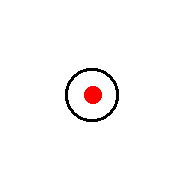
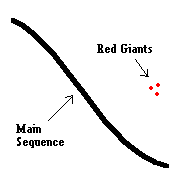
Temperatures within the shrinking helium core become high enough so that even helium fuses. Yes, at high enough temperatures you can actually fuse 3 helium atoms into a carbon atom. This new energy source causes the core to suddenly expand outward ... which pushes on the upper layers ... causing the sun to eject a substantial amount of mass into space. We see this as an object known as a planetary nebula.
Here are some beautiful examples of planetary nebula
Helix
Nebula
The Ring
Nebula
Cat's Eye
Nebula
Butterfly
Nebula
Eight Burst
Nebula
Each of these images have something in common ... a small object is left behind after this "mini-explosion". It is the remnant exposed core of the red giant. The planetary nebula phase was triggered by a "helium flash" in this core when it underwent fusion. Only this fusion was a fusion of helium to carbon. So this exposed core is a very hot ... dense ball of carbon atoms about the size of the earth. Technically it isn't really a star ... because there is no fusion anywhere in this core, but .... it is still called a star with the name white dwarf. When you heard the nursery rhyme .. Twinkle, twinkle little star ... how I wonder what you are, this object really is a "diamond in the sky". Astronomers are currently finding that about 10% of all "stars" are white dwarfs. The number may be even higher. White dwarf appear on the H-R diagram in the lower left corner.
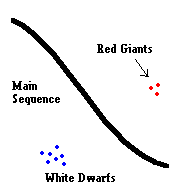
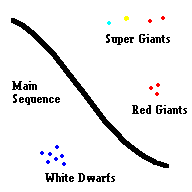
 |
The story of super giants gets even stranger. The carbon core contracts further and reaches high enough temperature to fuse carbon to neon, then neon to oxygen, then oxygen to silicon, then finally silicon to iron. When the iron core reaches a critical mass ... it suddenly collapses ... reaching nuclear densities and superheats. In addition, the shock wave of this event ripples through all the layers above the core ... superheating each layer as well. This produces fusion reactions of all kinds resulting in a supernova explosion. For one brilliant month, a single star burns brighter than a whole galaxy of 200 billion stars. Supernova explosions inject carbon, oxygen, silicon and other heavy elements up to iron into interstellar space. They are also the site where most of the elements heavier than iron are produced. These heavy elements are ejected into space and eventually become incorporated into future generations of stars and planets. Without supernova, the fiery death of massive stars, there would be no carbon, oxygen or other elements that make life possible. In a very real sense ... we are all made from the death of these massive stars!
Crab Nebula - In 1054 Chinese astronomers reported seeing a "guest star" ... visible even during the daytime. Today we see the result of this explosion as the crab nebula.
Cas A Supernova
Supernova 1987 A - the most recent supernova visible without the aid of a telescope.
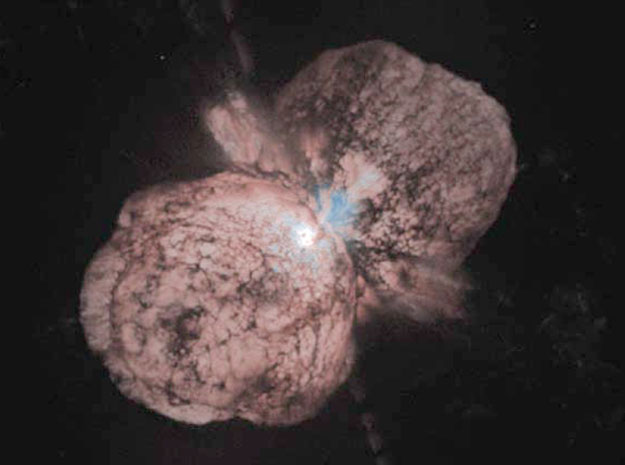
Credit: J. Morse (U.
Colorado), K. Davidson (U. Minnesota)
et al.,
WFPC2,
HST,
NASA
| Mass of Original Star | Main Sequence lifetime | How it explodes | What it leaves behind |
| less than our sun | longer than the universe is old | it doesn't | white dwarf (which cools to a black dwarf) |
| mass like our sun | about 10 billion years | planetary nebulae | white dwarf (which cools to a black dwarf) |
| slightly more than the sun (~15x) | a few 100 million years | supernovae | neutron star (if > 1.4 solar masses) |
| much more than our sun (~70x) | only ~10 million years | hypernovae | black hole (if > ~3 solar masses) |
ŠJim Mihal 2004 - all rights reserved